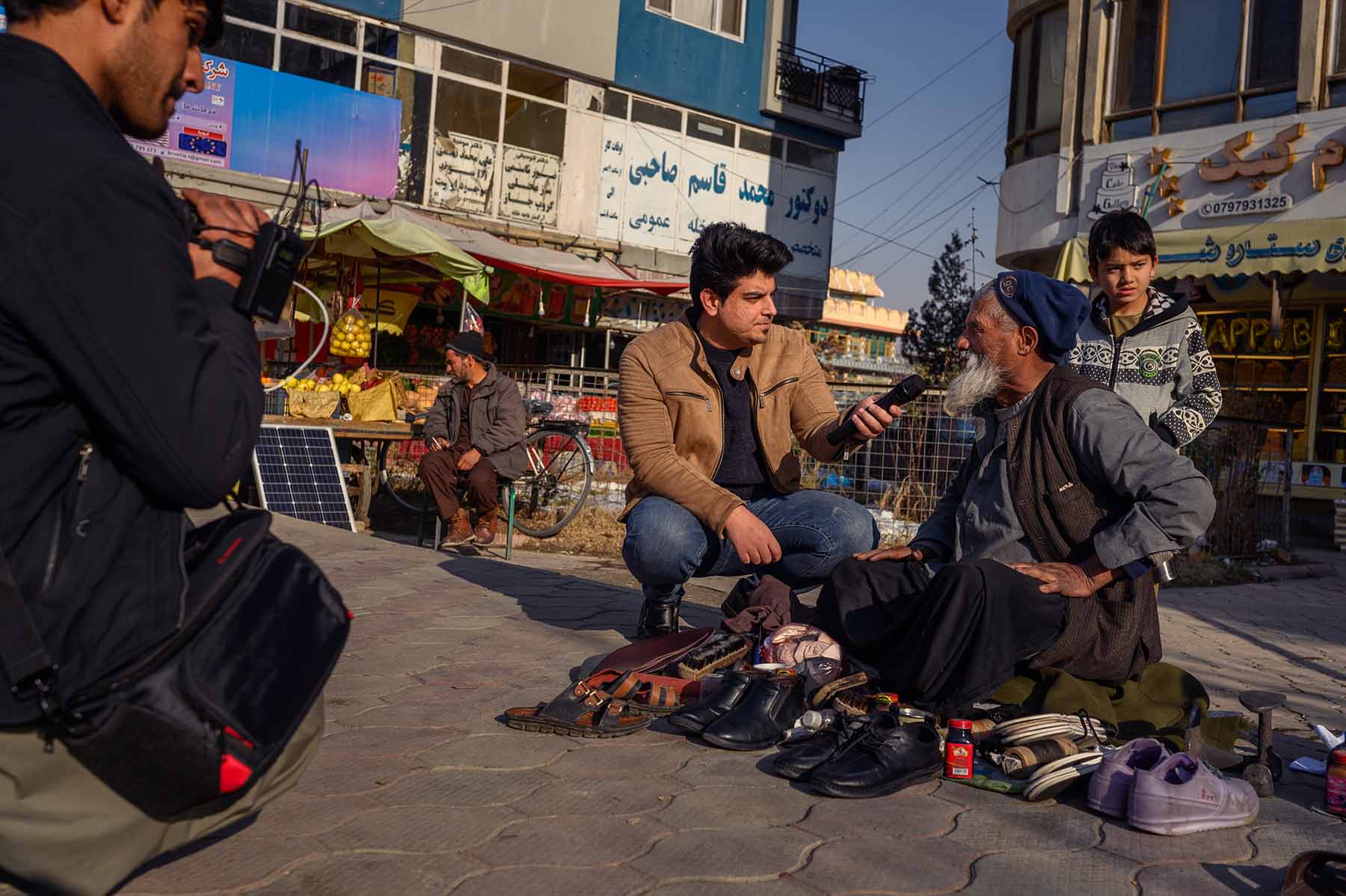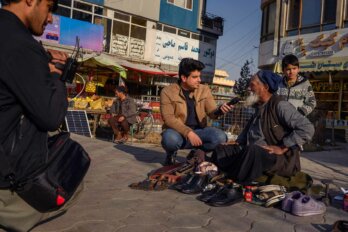
This article is also available in Dari, translated by Said Najib Asil.
Hamed Latifee launched the YouTube channel Afghanistan Streets in 2023 to portray daily life in the country under Taliban rule. His videos often featured tours of construction sites, shops, or trips to Afghanistan’s provinces, where locals would showcase traditional foods or handicrafts. A frequent guest on his show was Rafiullah Ahmadzai, then a Kabul municipal officer; in one video posted last December, Latifee and Ahmadzai deliver bundles of wood for heating to an orphanage and an educational centre. They pat the children’s heads, ruffle their hair, and sit down with them to listen to their concerns. In a later segment, Ahmadzai tells Latifee that he gets funding from businessmen and investors, some of whom are outside Afghanistan, to distribute aid in the city.
In March, several Afghan content creators’ YouTube channels, including Latifee’s, were taken down in response to reporting from the Washington Post. “If we find an account believed to be owned and operated by the Afghan Taliban, we terminate it,” a YouTube spokesperson wrote in an email to The Walrus. “Further, our policies prohibit content that incites violence.” Tech platforms have targeted Taliban-affiliated accounts in the past; in 2022, Meta shut down the Facebook and Instagram accounts of the state-run Bakhtar News Agency and Radio Television Afghanistan. In 2023, the New York Times reported that WhatsApp was blocking the accounts of Taliban officials, soldiers, and police.
Latifee insists he doesn’t work for the Taliban. A former journalist, he says he generates much of his income from YouTube ads; in February, Afghanistan Streets had nearly 29,000 followers. Since losing access to it, he’s started a new channel under his own name and says he plans to continue profiling humanitarian projects in Afghanistan. “And I will follow the YouTube policy,” he says.
Zabihullah Mujahid, the Taliban’s official spokesperson since 2007, also denies the group’s involvement in any third-party promotional content. But Afghans who want to start YouTube channels are required to get a permit, a policy Mujahid says is a holdover from the previous government. Under the Taliban, he says, these permits are meant to ensure that videos comply with Sharia law, that they are in the country’s interests, and that they avoid spreading what he calls fake news and negative propaganda. In other words, if a YouTube channel operates out of Afghanistan, it’s likely endorsed by the Taliban.
YouTube is one pillar of the Taliban’s evolving social media strategy, which also includes X, WhatsApp, and Telegram, in an attempt to gain legitimacy both domestically and internationally, since no country recognizes the extremist group as Afghanistan’s official government. Mujahid’s posts on X, like those of many Taliban officials, tend to focus on economic development, such as an ongoing project to extend electricity lines to some provinces. He can be quick to congratulate the Afghan cricket team when it’s victorious.
Mujahid says he favours X for its mass appeal. The platform’s policies are also more forgiving than those of some other social media giants: pro-Taliban accounts are not automatically banned, though the tech company’s spokespeople have said they take down any posts that glorify violence or promote hate speech, among other infractions. While Mujahid has had previous accounts on what was then known as Twitter suspended, as of early April, his current handle, @Zabehulah_M33, had nearly 1 million followers. (By comparison, the official account of the White House press secretary has 2.2 million followers.)
That a modern-day government would try to engage citizens or manage its image through social media is not surprising. But during the Taliban’s initial reign, between 1996 and 2001, they banned television, music, and photography, among other forms of entertainment; in 2001, they cut off internet access for most Afghans. When the Taliban returned to power nearly three years ago, there were widespread fears that they would sever Afghans’ links to the outside world and to one another. Amid high levels of unemployment and government restrictions, there are scant opportunities for networking, whether for social or professional purposes. There’s little to do for entertainment; the Taliban, for example, have clamped down on wedding festivities and banned women from public parks and gyms. Platforms like X and YouTube are often the only spaces in which many Afghans can connect, get noticed, and air their views, including political ones. Even as the Taliban try to suppress some of that activity—TikTok is banned, and in early April, officials announced plans to restrict or completely block Facebook—they also depend on it.
According to a September 2023 article in the Afghan newspaper Etilaatroz, Taliban officials allegedly offer up to 10,000 Afghanis per month, the equivalent of about $190, to individuals to promote the group’s propaganda and troll social media posts that are critical of the Taliban. (Around ninety influencers are thought to be employed in this way.) Mujahid refutes this: while government ministries have what he describes as social media departments, he insists the Taliban do not pay third parties for promotional content. He says he believes content creators like Latifee or Jamil Qadery, who’s based in Europe and hosts a YouTube talk show in which he often defends the Taliban’s policies, do this work because they “feel responsible for their country and do not want war in the country.”
But the Taliban’s embrace of social media wasn’t born of a path to moderation, says Michael Semple, a research professor at the Senator George J. Mitchell Institute for Global Peace, Security and Justice at Queen’s University Belfast. Though some videos feature young hosts and influencers, he says, it’s misleading to suggest that today’s Taliban are led by a new generation, replacing the one that was previously in power. “Most of the senior positions in the movement are handled by people who had the same office in the 1990s” and during the twenty-year insurgency, says Semple. In essence, “this really is the old movement coming back to power with the ideology and culture and the political dynamic intact, with no change in twenty years.”
The Taliban were quicker to adopt an online presence than their puritanical ideology might suggest. The group launched its first website in 1998. After its fall from power later, in 2001, it broadcast its continued survival online. In 2005, it launched the official website of the Islamic Emirate of Afghanistan, which today offers content in Arabic, Pashto, Dari, Urdu, and English.
After the US-led invasion of 2001, many Taliban insurgents fled to Pakistan, where they were in close contact with al-Qaeda, the terror network that gained notoriety for broadcasting the beheadings of those it considered enemies. The Taliban began using al-Qaeda media studios in Pakistan to produce videos of IED attacks and other forms of violence, says Christopher Ankersen, a clinical professor at New York University’s Center for Global Affairs. To advertise their military capabilities, says Ankersen, they emulated “not only the tactics but also literally the hardware and a technical know-how of other extremist groups to be able to produce this kind of stuff.”
Meanwhile, Afghanistan, too, was changing. After the US-backed government came to power in 2002, it widened internet access, increased the number of cellphone towers, and lifted a ban on television. (By 2023, it was estimated that about 18 percent of the population used the internet, and about 8 percent had social media access.) Over the following two decades, the Taliban harnessed this opportunity to further their outreach, recruitment, and fundraising efforts and disseminate propaganda online, so much so that some of their leaders credit social media for their return to power. “Our enemies have television, radio, verified accounts on social media, and we have none,” Qari Saeed Khosty, who was then effectively the Taliban’s social media director, told the BBC in September 2021, “yet we fought with them on Twitter and Facebook and defeated them.”
The Taliban’s nimble media outfit meant that their videos and images of attacks against Afghan and international coalition forces were often the first to reach global audiences, placing the onus to respond on the Afghan government and its allies. And in the years and months leading up to the withdrawal of US forces in 2021, social media allowed the group to maintain what Ankersen describes as a spectral presence: “They could be everywhere at once, even if that weren’t actually true on the ground.” Official Taliban accounts regularly tweeted updates about their insurgency, framing their attacks as victories against foreign invaders and amplifying the organization’s progress as it gained control of one province after another.
The Taliban also used encrypted apps such as Telegram and WhatsApp to demonstrate their capacity for governance and try to win over the Afghan population. They hosted what were essentially service-delivery channels, says Ankersen—the message being: “So you’ve got a problem. Reach out to the Taliban, not to the government, and we will sort it out for you.” The group promised to fill gaps in health care and other areas where the government was failing its citizens. But this commitment came with a more frightening guarantee: just as the Taliban could be easily accessible, they would also use these platforms to target citizens. They conducted night-letter campaigns, an intimidation tactic that typically involved printed or digital missives issuing threats to individuals or communities as punishment for supposed wrongdoing.
Despite al-Qaeda’s influence, the Taliban’s content differed from that of some other extremist groups. Unlike Daesh, also known as ISIS, and al-Qaeda, the Taliban don’t necessarily seek to expand their rule or enlist fighters from abroad. Before returning to power, according to a report from George Washington University, their focus was always on winning back Afghan self-determination from Western forces, as the Taliban often framed it. Many of their online posts promoted anti-US, anti-imperialist messages and dismissed the foreign-backed government as corrupt. The Taliban, they claimed, were truer representatives of the Afghan population.
During the 2019 peace negotiations in Doha, in advance of the US withdrawal from Afghanistan, some hoped for a power-sharing arrangement that would see the Taliban collaborating with the Afghan government. The Taliban committed to a four-component peace process, which would include a transition period as US forces withdrew and the Taliban gained more recognition as part of the government. There was widespread talk of a so-called Taliban 2.0—a more restrained, peaceable incarnation of the fundamentalist group. But “the perception that was created in Doha never really materialized,” says Lotfullah Najafizada, an Afghan journalist who attended the talks and is now CEO of Amu TV, based in Washington, DC.
After retaking power, the Taliban’s social media positioning changed to try to reflect their new status as Afghanistan’s official government. Accounts associated with the Taliban proliferated on Twitter, now known as X, and Facebook, framing the group as a peaceful, unifying governing force, unlike other terrorist groups. (When ISIS-K, a branch of the Islamic State, claimed credit for a deadly mass shooting at a concert in Moscow this March, Abdul Qahar Balkhi, spokesperson for Afghanistan’s ministry of foreign affairs, posted that his government condemned the attack and “considers it a blatant violation of all human standards.”) Where they once used WhatsApp to subvert the US-backed government, Taliban officials in various ministries now distribute press releases, photos, and videos to journalists on the messaging platform. But while the Taliban have become media savvy, says Semple, they are no less authoritarian. Provincial government officials make it clear to journalists that nothing is to be published or broadcast without their approval. Afghans who criticize the Taliban on social media often receive messages threatening them or their families.
The Taliban are a fractured group, divided along regional and generational lines, among other differences. But an overarching goal for some branches is to cement the Taliban’s brand as a beacon of Islam, says Ankersen. News coverage of Taliban-sanctioned human rights violations—including field courts and stoning and flogging of adulterers, for instance—doesn’t necessarily count as bad press. For the Taliban, such accounts simply demonstrate the group’s adherence to Sharia law. (Many scholars of Islam would dispute their violent interpretation.) “They believe that power comes from God,” says Najafizada. “That’s where the legitimacy of the regime comes from, and I think that is not reconcilable with the reality of [most of] the Afghan society.”
In the Taliban’s attempt to establish their image as a “normalized and regularized government,” says Ankersen, a portion of their intended social media audience are foreign powers. Official Taliban social media channels tend to broadcast content in multiple languages, including English, in part to draw the attention of potential investors and allies.
Nargis Nehan, a former Afghan politician who previously served as the acting minister of mines and petroleum and is now based in Toronto, says many public works projects that officials boast about on X were started by the previous government. For twenty years, she says, the Taliban were on the outside, “but it looks like they were very carefully following what was happening.” Though Taliban officials regularly demonize members of the previous government, since returning to power, “they have maintained what is serving their interests, and they are ignoring and denying what is not serving their interests.”
Demonstrating stability is crucial as the Taliban seek outside investment, says Ankersen. Recently, for example, Taliban leaders reportedly consulted with China-based Huawei Technologies about installing surveillance cameras in Kabul and other large urban centres. Such infrastructure, says Ankersen, would presumably allow the Taliban to monitor citizens for Sharia compliance, including ensuring that women are adequately veiled in public and always accompanied by a male, or that people aren’t playing music, which is outlawed. (The Taliban have said the system would help clamp down on Islamic State attacks, denying that it would breach the rights of Afghans.) Nehan also believes the Taliban are using women’s rights as a bargaining chip for recognition from the international community—which would increase their chances at long-term survival.
The Taliban can’t afford to be as disconnected from the outside world as they once were. At one time, 75 percent of Afghanistan’s public spending came from international donors, according to a 2019 World Bank estimate. Much of that flow has stopped or slowed down since August 2021. A 2023 UNICEF report estimated that about 29 million Afghans, or about 70 percent of the population, are in need of humanitarian aid. A separate report from 2023, produced by the United States Institute of Peace, found that the Taliban have “effectively infiltrated and influenced” aid money the country still receives, largely from the UN.
The international community faces an ongoing dilemma: supporting Afghans without underwriting human rights abuses. The Taliban have denied girls an education from grade six onward. They have reinstated the ministry for propagation of virtue and prevention of vice and barred women from public spaces. In December 2022, they announced that women were no longer permitted to work in most local and international non-governmental organizations, which further restricted humanitarian aid from reaching women and children. (While the ban has since been walked back, it had lasting impacts on aid.) A predominantly Pashtun group, the Taliban have trampled the rights of ethnic minorities. Taliban members have engaged in extrajudicial killings, detained and tortured protesters calling for women’s rights, and restricted journalistic freedoms, leading to the closure of more than 200 news organizations. In short, the Taliban, says Najafizada, are “turning the country into one of the most oppressive countries in the world, for women in particular.”
When the Taliban returned to power, “for the first eight months, they were different,” says Mahbouba Seraj, a women’s rights activist who was shortlisted by the Peace Research Institute Oslo for the 2023 Nobel Peace Prize. During that initial period, she says, “you could actually have a discussion and talk.”
At a three-day summit in Oslo in January 2022, Seraj and other Afghan civil society leaders, journalists, and influential figures met with Taliban representatives to discuss their country’s future. The Taliban diplomats seemed to display goodwill. But that progressive image was shattered a few months later, when the Taliban refused to reopen girls’ schools, closed since the previous fall.
If there is any silver lining while the Taliban have trampled free expression, Semple says, it is that they haven’t shut down social media entirely. That means some Afghans can still share information, protest, and reach a global audience.
Hoda Khamosh, an author and activist who was named one of Time’s 100 most influential people in 2022, also attended the meeting with the Taliban in Oslo that year. She moved to Norway permanently a few months later, amid threats to her life. She helped co-found the Afghan Women’s Justice Movement, which, among other things, has opened secret schools for girls in Afghanistan, given women opportunities to earn an income by selling handicrafts such as traditional embroidery online, and delivered mental health programs. She also continues to mount a resistance on social media. “We believe the Taliban cannot be reformed,” she tweeted in May 2022. “Stop normalizing our oppressors.” Her posts on X sometimes include images of bruises and injuries sustained by women protesters who say they were detained and beaten by members of the Taliban. Protesters send her photos and updates, she says, because she can post them safely from abroad and attract international attention.
Khamosh says Taliban supporters have attempted to discredit her posts in replies and reposts, claiming she works for the US. Some have sent her direct messages on Facebook and X, occasionally threatening her and her family members in Afghanistan. Mujahid says the Taliban aren’t involved and that they’re open to criticism from citizens when it comes to everyday transactions such as getting paperwork done. Asked about online activists who protest the Taliban’s policies toward women and girls, he says issues such as education are a matter of policy and are too big to be resolved on social media. But there is a small contingent of opponents, he says, who will always be dissatisfied. “The Taliban have security forces,” he says, “and we can deploy those forces if an investigation is needed or even [detainment] if need be.”
Some Afghan women influencers have stopped filming in public or posting content since the mysterious death of Hora Sadat, a prominent Afghan YouTuber, in August 2023. While the Taliban, including Mujahid, insist her death resulted from a family dispute, many fear she was targeted for her online activity—and that they themselves might be next. Even YouTubers sympathetic to the Taliban are heavily policed. This past March, Humayun Afghan, who interviews Afghans about everyday life on his popular YouTube channel and avoids criticizing the Taliban, was briefly detained along with four colleagues; officials said a woman had filed a complaint against him for broadcasting footage of her without her permission.
To Khamosh, the Taliban’s repressive approach works against them. Afghan activists “document their behaviour and publish videos and film the crimes of the Taliban, all of which show that the Taliban have not changed at all.”
“The obvious analogy is you take a cigarette packet” and dress it up with pictures of wildlife, waterfalls, or a smiling baby, says Semple. But inside are still cigarettes “which will give you cancer.” That’s the Taliban today, says Semple: “it’s the same old cigarettes.”
The translation of this article into Dari was made possible by the generous support of Naim Ali.

Former Journalists for Human Rights Fellow










